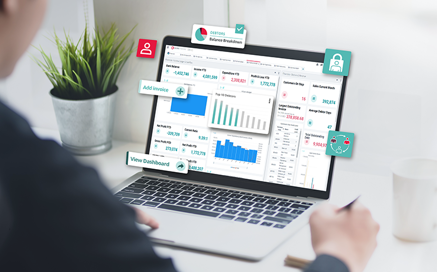
How to implement a new accounting system - your migration checklist and guide
Switching accounting software can make a huge difference to the way your business works. Up to date systems can speed up your finance processes and increase efficiency. A new accounting system can also deliver better reporting, more timely information and drive value through insight.
If you’re ready to bring your finance function up to date, how do you kick off the accounting system migration? And what things do you need to do to prepare for a smooth transition?
This article is your accounting system implementation plan. It covers everything you need to know about how to do it well. We include a downloadable accounting system migration checklist so you can tick off each step as you go along.
 10 minutes
10 minutes
Written by Stuart Walker, Finance and Turnaround Director
Use our guidance for a successful accounting system implementation. Included on this page...
How do you implement a new accounting system?
Rolling out a new accounting system is quite a scary prospect for many. It’s a massive task and there is a lot to consider at every step in the process – such as building the business case to change software, creating your project team, assessing vendors and planning the rollout of the system.
Being organised and having a clear plan of action is often the best way to ensure a seamless transition to new accounting software that will deliver value for many years to come. Being careful to document everything, monitor your task list daily, and communicate what you are doing to key stakeholders are among the most important considerations.
8 tips for a successful accounting software implementation
When rolling out new accounting software, it’s important to take the following steps to ensure you and your team are fully prepared for the move, have complete buy-in from the business, and all the right tools and expertise to hand to support a seamless transition.
As you follow the 8 tips below, you can use the accounting system implementation checklist to tick off as you go along.
1. Build a strong business case for implementing a new accounting system
Before you even start with your project you are probably going to have to make the case for spending time and money implementing a new accounting system.
Your company may have a proforma that you need to complete, or in smaller businesses, you may just need to make your case to the board or the CEO.
Hints for what to include in your business case for a new accounting system:
- You can do more with less - more efficient accounting software means that you can either reduce your headcount or won’t need to recruit as quickly when the business grows
- You can give your customers (internal and external) better service - better accounting software means better information and better data analysis capabilities
- You can provide better insight into the business - insight rather than numbers. You’ll have more time to become a finance partner to the business
If you haven't written a business case before, or you’d like some tips about writing a winning proposal, check out our handy whitepaper.
If you've not yet chosen your new accounting software, we have an article which might help. Take a look at How to choose the right accounting software for your business.
2. Be prepared to communicate updates throughout the accounting system implementation
The key to a successful project and to having new accounting software positively adopted is to have great communications.
Rumours can be terrible things and if someone gets wind of a change that is happening then you may find that all sorts of different stories do the rounds.
Start by identifying your key stakeholders which could include; finance users, wider business users, suppliers, customers, directors and senior managers.
All the way through the aim is to make sure your stakeholders fully understand what is going on and how it will affect them.
Make sure that you have a good communications plan with regular updates and pay attention to your important stakeholders. Also, have a way that people can provide feedback.
3. Chunk up the accounting system implementation project
Don’t be tempted to try and do everything all at the same time because that is a recipe for disaster.
Instead, break your project up into manageable chunks and deal with each in turn, that way you and your team won’t get dispirited before you even start.
Split your project down into large blocks to start with, then fill in smaller blocks within the larger ones. Consider the wider business picture. What things do you need to put into the ‘quick wins’ box and what things can be done later? Make sure also that you talk to the business about the vision for the future.
It can be useful to use a spreadsheet to manage your chunking up or commercial planning tools like Asana, Trello or Notion can help.
4. Do a data cleanse before the accounting system implementation
Clean data is good data so make sure that you are only importing data that is accurate. This means that you may need to take time to go through things like your balance sheet accounts and get rid of odd balances that have been there since the dawn of time.
A good example here would be to only bring across customers who have bought in say the last two years rather than every record of every customer who has ever bought from you!
So before you carry out any data migration you need to do a full data cleanse. Again, remember to chunk it up and start with something easy like your supplier list.
Our everything guide to switching finance software includes a handy section on ‘Clean data is good data’ and ‘migrate what you need, not what you want’. Download your copy.
5. Implement what you need, not what you already have
Don’t be tempted to try and simply replicate how your current systems and processes work because you may just be trying to build in inefficiency.
Instead have a fundamental review and ask yourself why you are doing things in a particular way. If it doesn’t make sense then bin it.
Discuss your finance challenges with your potential software suppliers, see how their solution can help empower your finance team.
6. Test everything
With the best will in the world, no software developer can possibly hope to get a new accounting system that will work for every company in every sector right out of the box.
So make sure you set aside time for proper testing. This is also helpful because it gives you a chance to use the system, get used to it and see if there is any functionality that can help you do things better.
Your testing may be split down into Beta and User Acceptance Testing (UAT) testing phases.
Beta testing will be done by the project team and will check basic functionality following configuration.
UAT testing is the gold standard for your organisation. This is designed to make sure that ordinary users can work the system, find the functionality that they need and that the system is delivering the results that they expect. This is also where you are checking that data is imported correctly and workflows etc act as you expect.
7. Train your people on the new accounting system
Setting up a new accounting system would not be possible without training to help your teams get up to speed on the software.
A good training programme will help people to understand how to do their roles, find features in the system that they may need and introduce new functionality that their old system may not have had.
With Access Financials, training is a quick and easy step in the implementation process as our software is intuitive and user-friendly so it doesn't take a lot of getting used to. Our expert team deliver dedicated training programmes to our customers, and we provide ongoing customer support via our client portal – which includes articles, videos and community forums. Download a brochure to find out more about our finance solutions.
8. Continue to modernise and improve your accounting systems
Once your system is in place and you are happy with it then it is tempting to let sleeping dogs lie but this is a big mistake.
There is so much more than modern accounting systems can do that you really need to make sure you push your new software to add even more value.
Make sure you are using effecting integrations using our excellent API and look at the other systems we have in the Access stable such as payroll, HR and project accounting.
A simple migration checklist for implementing new accounting software
For many, having a checklist is a highly beneficial way to manage the implementation process. The accounting system migration checklist is easy to use and customisable, so you can tailor it to your organisation and use it as a key project planning document to monitor and report on progress.
How we support businesses to implement new accounting software
Our implementation and success teams have helped thousands of companies through the accounting system migration process over the years and we’re here to help you.
We start with a full fact-finding exercise, to really understand what you are looking for from your finance management systems. We’ll work with you to produce an accounting system migration plan and we will be with you every step of the way as you work that plan.
Our project management teams know the product inside and out and are able to help you configure it in just the right way to deliver exactly what you need.
And when the project is over, our customer success team will monitor your software to ensure that it remains at peak efficiency and will even suggest functionality that might not be being used but that could help you speed up your work.
What our customers said about our support:
Why implementing new accounting software could empower your business
There are so many reasons why a new accounting system implementation could benefit your business.
The initial benefits are simply a result of time. If you have outdated accounting software then you’ll find that more modern software is faster, more secure, more stable and more capable than your old one.
You also reap the benefits that come from using a more capable system. Your old software may have been suitable when you were a smaller business with fewer requirements, but as your business grows you need something that has more functionality, better configuration and better integrations to scale up and meet demand.
And finally, we have the real value-add benefits that come from a new accounting system implementation - insights. Better software means that more data is available, more quickly.
This means that you can provide your management team with insights into their business that help them develop a real competitive advantage.
If you've not yet chosen a new accounting system for your organisation, see if ours is the right fit for you. Our accounting system has 8 easy-to-use features allowing you to customise the system to suit your organisation. Book a demo of our accounting software.
Want to know more?
Have a read through more accounting software information, guidance and advice.






